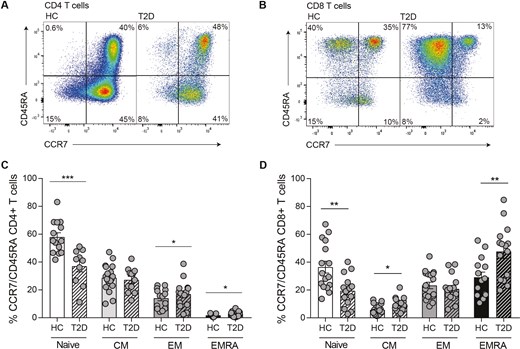-
PDF
- Split View
-
Views
-
Cite
Cite
Sian M Henson, Response to Letter to the Editor: Type 2 diabetes is associated with the accumulation of senescent T cells, Clinical and Experimental Immunology, Volume 219, Issue 1, 2025, uxad078, https://doi.org/10.1093/cei/uxad078
Close - Share Icon Share
Dear Editors,
Thank you for giving us the opportunity to clarify the issues raised by Zheng and Huang in our 2019 paper titled ‘Type 2 diabetes is associated with the accumulation of senescent T cells’.
We would like to confirm that the percentages stated in the left hand flow panel of Fig. 1a are incorrect. We manually write the percentages onto the plots so that they can be read more clearly and believe that both the EM and CM panels have been incorrectly labelled. We have corrected this and have produced a revised figure.

Elevated levels of T cell senescence in people living with type 2 diabetes. The accumulation of senescent T cells in diabetes was defined using the markers CCR7 and CD45RA in T cells from patients with type 2 diabetes and healthy controls aged over 55 years. Representative flow cytometry plots are shown for CD4+ (A) and CD8+ (B) T cells. Cumulative data of the phenotypic staining is shown for CD4+ (C) and CD8+ (D) CCR7/CD45RA defined T cell subsets. Data expressed as mean ± SEM of 16 healthy and 16 T2D donors. P values were calculated using a T-test.
We export all the raw data from Flowjo using the table editor to remove the possibility of mistyping, the cumulative data shown in Fig. 1c is correct and the reported statistic stand as published. The error has arisen solely as a consequence of mistyping and a failure to adequately check the written percentages.
Our finding that people with type 2 diabetes have a higher percentage of highly differentiated T cells has been shown previously: Pedicino et al., J Diabetes Res 2013; 2013: 184258. In this paper, the authors show that in both types 1 and 2 diabetes, there was a higher frequency of CD4+ CD28− T cells. Our paper further defines the CD28− population into EM and EMRA subsets using CCR7 and CD45RA and found both subsets to be elevated in type 2 diabetes. Therefore, we stand by our conclusion that T2D drives the differentiation of T cells giving rise to premature T cells senescence.
Conflict of interests
Not applicable.



